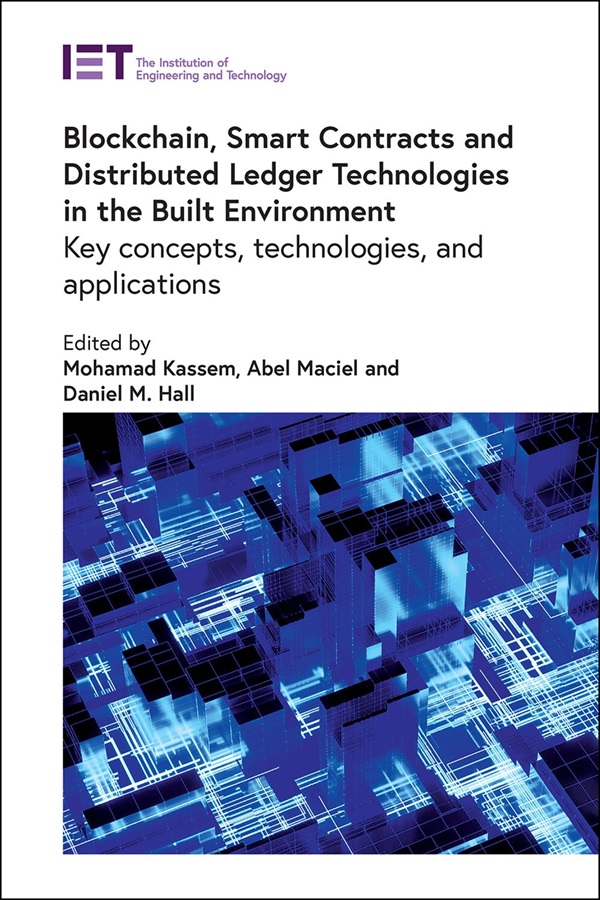- Agricultural Engineering and Technology
- Applied Physics
- Built Environment
- Computing and Networks
- Control, Robotics and Sensors
- Electrical Regulations
- Electromagnetics and Radar
- Energy Engineering
- Healthcare Technologies
- History and Management of Technology
- IET Codes and Guidance
- Manufacturing
- Materials, Circuits and Devices
- Model Forms
- Security
- Telecommunications
- Transportation

Blockchain, Smart Contracts and Distributed Ledger Technologies in the Built Environment
Key concepts, technologies, and applications
Edited by Mohamad Kassem, Abel Maciel, Daniel M. Hall
The built environment, encompassing the spaces we inhabit, the infrastructure that connects us, and the systems that sustain our societies, is foundational to human progress. It shapes how we live, work and interact, serving as a fundamental for social and economic prosperity. Yet, despite its importance, the sector faces enduring challenges: inefficiencies, insufficient collaboration, significant environmental impact, and a slow pace of transformative innovation, particularly in areas such as value creation, business model evolution, and major sector-wide transformations.
Digitalisation and digital transformation, driven by technologies such as building information modelling (BIM), the internet of things (IoT), artificial intelligence, and immersive technologies, have become essential in helping the sector address these issues. More recently, distributed ledger technologies (DLT), such as blockchain and self-executing contracts like smart contracts, have emerged, offering further opportunities for the built environment.
Emerging evidence, as explored in this book, highlights DLT's capabilities in transparency and trust (immutable records and enhanced accountability), efficiency and automation (smart contracts and streamlined processes), data security (decentralised integrity), collaborative governance (shared decision-making), tokenisation (democratised ownership), integration (synergy with digital twins, BIM and IoT), and sustainability (circular economies, renewable energy). However, adoption in the built environment faces several challenges, including legal, technical, ethical and stakeholder barriers.
Combining theoretical and practical perspectives, this book examines the potential of blockchain and DLT in both the delivery and management of the built environment, addressing their adoption frameworks, applications and associated benefits and challenges.
Intended for researchers, practitioners, students, technology developers and policymakers, Blockchain, Smart Contracts and Distributed Ledger Technologies in the Built Environment: Key concepts, technologies, and applications is a comprehensive guide to the adoption and integration of DLT in the built environment.
About the Editors
Mohamad Kassem is a professor of digital construction at Newcastle University, UK, and leads the NU-DICE Lab. His interests include construction digitalisation, focusing on technical advancements, process innovation, and policy development. He has held consultancy roles with the European Commission, UK FCO, CITB, and governments of Brazil and Mexico. He has authored or contributed to more than 160 publications, has been awarded £12 million in R&D funding, and is the recipient of multiple awards.
Abel Maciel is a practicing architect and associate professor at the Bartlett Faculty of the Built Environment, University College London (UCL), UK. He has contributed to research at the Space Syntax Laboratory, the Bartlett School of Architecture, and the Bartlett School of Sustainable Construction. He is the founding director of Design Computation and also of the Construction Blockchain Consortium. He serves as an advisor on Blockchain and AI policy in the British Parliament.
Daniel M. Hall is an assistant professor in the faculty of Architecture and the Built Environment at Delft University of Technology, The Netherlands. He is founder and organizer of the Stanford Industrialized Construction Forum. He holds several international leadership positions including for the European Conference for Computing in Construction, the International Association of Automation and Robotics in Construction, and the Construction Blockchain Consortium.
Publication Year: 2025
Pages: 468
ISBN-13: 978-1-83953-834-6
Format: HBK
